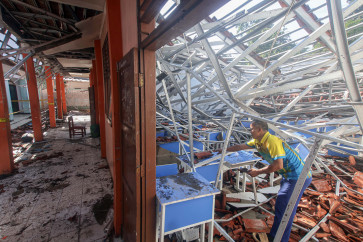Popular Reads
Top Results
Can't find what you're looking for?
View all search resultsPopular Reads
Top Results
Can't find what you're looking for?
View all search resultsRI film festival takes on Australian silver screen
Two worlds: In Di Dasar Segalanya (At the Very Bottom of Everything), directed and produced by Paul Agusta, the main protagonist’s soul is blown into pieces by a dreadful bipolar disorder
Change text size
Gift Premium Articles
to Anyone
T
span class="caption" style="width: 398px;">Two worlds: In Di Dasar Segalanya (At the Very Bottom of Everything), directed and produced by Paul Agusta, the main protagonist’s soul is blown into pieces by a dreadful bipolar disorder. It is now winter festival time in the southern cities of Australia – the perfect opportunity to watch the world unravel, huddled in a warm cinema room while temperatures outside sink below 10 degrees Celsius.
The 5th Indonesian Film Festival (Aug. 20 – 29) in Australia, usually held in Melbourne, also came to Sydney this year, a sign it is increasingly becoming part of the established art festival scene in the land down under.
The fact that all feature-length films, barring one, were screened at the ACMI (Australian Centre for the Moving Image), a venue known as the home of world cinema in Melbourne, highlights the festival has reached international standards.
The festival organizers put a great deal more thought in the film selection this year, handpicking movies that provided clear social commentary without neglecting the story-telling. Themes broached included women’s issues, inequalities, as well as hurdles encountered in the on-going process of nation building.
Like last year, the feature film selected for the educational category was entertaining as well as informative. If last year’s audience found Laskar Pelangi gently heart-warming, this year’s Ruma Maida was more frenetic, moving incessantly between the past and present.
Directed by Teddy Soeriaatmadja and produced by Deddy M. Husna, the film tells the story of Maida, a university student who in her spare time teaches street children, squatting a seemingly abandoned house. The more she digs into the history of the house, the more she unearths stories from Indonesia’s colonial past. But a rich developer, played by Frans Tumbuan, threatens to demolish the house, and bury its treasures of history, to erect a shopping mall instead.
The plot is cleverly woven into Indonesia’s independence struggle, involving several families around the late president Sukarno. After several twists of fate, which rather stretch the audience’s imagination, everything falls into place, and everybody lives happily ever after, or at least hopes and expects to do so.
The film also attempts to paint a more realistic picture of Indonesia’s society, where people do not necessarily fit into neat social, racial or economic categories.
Characters from different ethnic communities defy the stereotypes usually associated to them, while the eccentric millionaire property developer turns out to have a social conscience after all.
While many of the films selected for the festival place female protagonists at the center of the story, they also stray from assigning non-stereotypical roles to men.
For example, the opening film 7 Hati, 7 Cinta, 7 Wanita (7 Hearts, 7 Loves, 7 Women) directed by Robby Eranto Soediskam, draws sympathy, and sometimes revulsion or pity, not only for the main protagonist, obstetrician Kartini and six other women, but also for the male characters in the movie, who do not come across as stiff two-dimensional figures, but are alive in flesh and blood.
In fact, the movie unravels rather unpredictably, keeping the audience constantly guessing. And for those who believe all stories have to end well, this film is bound to satisfy them, closing with a happy ending at least for the main protagonist.
One film that did not, at least on the face of it, provide a social critic, was Di Dasar Segalanya (At the Very Bottom of Everything), directed and produced by Paul Agusta.
The film is a journey into the main protagonist’s soul, which is blown into pieces by a dreadful bipolar disorder. The film moves slowly, unapologetically testing the audience’s mental endurance. The images are grotesquely graphic, the music high-pitched and discordant most of the time.
Influences of baroque are found in some parts, probably not baroque at its goriest, but at its fiercest.
Some scenes come across as too long, especially when the psychological character is devoured by five monsters. Perhaps it was Paul Agusta’s aim from the start, to make the audience live the pain caused by bipolar disorders.
The festival, although screening many movies by young filmmakers, also made room for a 30-year-old culturally value-laden film, Perempuan Dalam Pasungan (Shackled Woman), by 66-year-old director Ismail Soebardjo. The story is about love, jealousy, family honor, conformity to tradition, and inevitably, community living.
After its screening, the producer Hendrick Gozali took questions from the floor, about the practice of shackling those perceived as mentally disturbed.
The most interestingly unconventional, at least to this reviewer, was the closing film, Di Bawah Pohon (Under the Tree) directed and produced by Garin Nugroho. This beautiful exposé of community life in Bali, portrayed intimately and realistically, weaves in the lives of three women, adding poignancy to the general story-telling.
The film was a wonderful treat and a learning experience, even to those who have perhaps already visited Bali but are not necessarily familiar with its customs. Di Bawah Pohon has pathos and humor, and is very Garin Nugroho, with no beginning, middle or end, or at least, none that stands out.
— Photo courtesy of Indonesian Film Festival Inc










